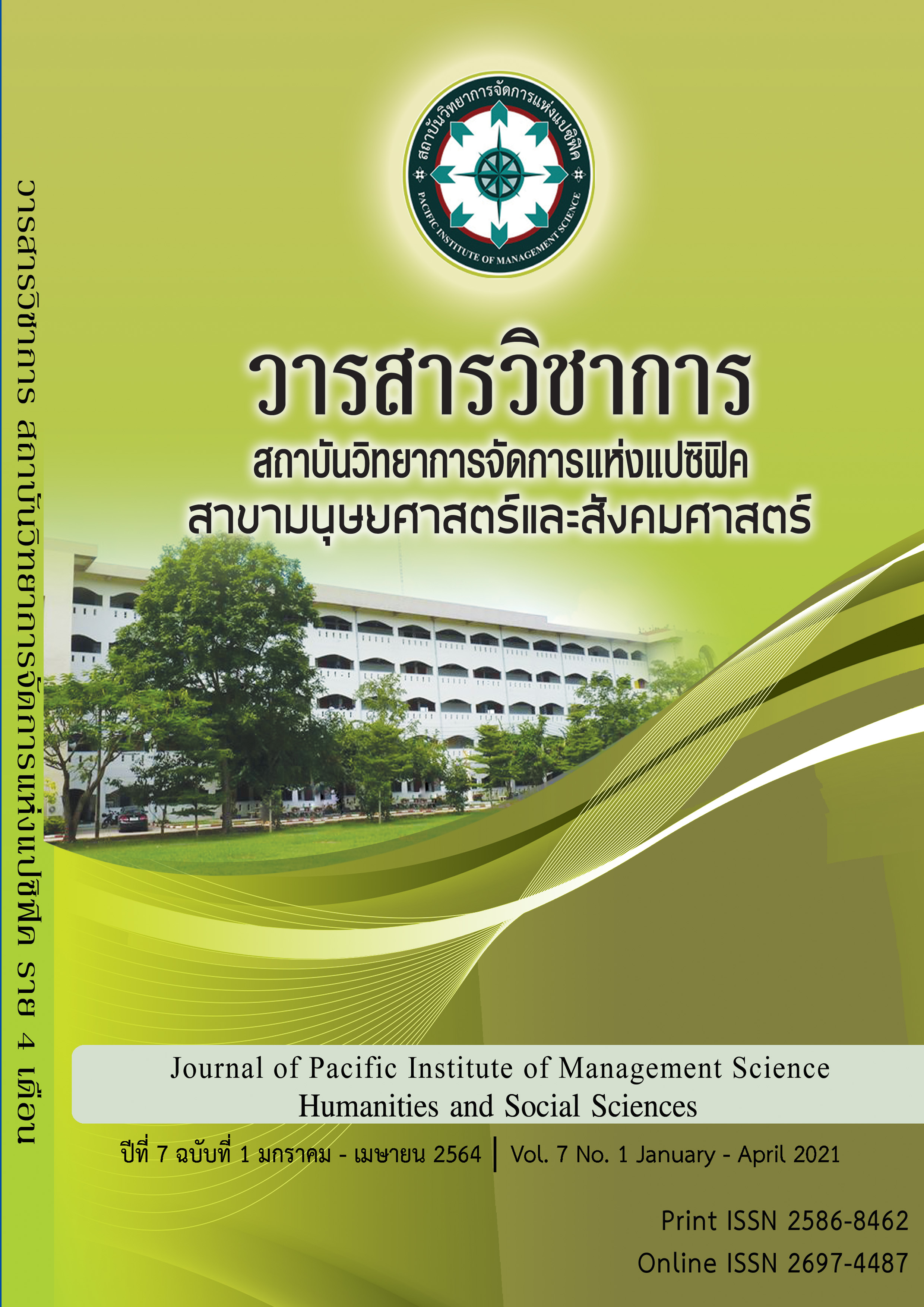การพัฒนารูปแบบการสอนอ่านวิชาการด้วยกลวิธีการอ่านแบบร่วมมือและกลยุทธ์การถามผู้เขียนเพื่อส่งเสริมความสามารถในการอ่านภาษาอังกฤษและการใช้กลยุทธ์การอ่านสำหรับนักศึกษาระดับปริญญาตรี
คำสำคัญ:
การอ่านวิชาการ, กลยุทธ์การอ่านแบบร่วมมือและถามผู้เขียน, ความสามารถในการอ่าน, การใช้กลยุทธ์บทคัดย่อ
การวิจัยนี้มีวัตถุประสงค์เพื่อ 1) เพื่อพัฒนาและหาประสิทธิภาพของรูปแบบการสอน อ่านวิชาการด้วยกลวิธีการอ่านแบบร่วมมือและกลยุทธ์การถามผู้เขียนให้ได้ตามเกณฑ์ 80/80 2) เปรียบเทียบความสามารถทางด้านการอ่านเพื่อความเข้าใจก่อนและหลังการใช้รูปแบบฯ 3) เปรียบเทียบความสามารถในการใช้กลยุทธ์ด้านการอ่านเพื่อความเข้าใจ และ 4) ศึกษาความคิดเห็น ของผู้เรียนต่อการใช้รูปแบบฯ
กลุ่มตัวอย่างเป็นนักศึกษาคณะศึกษาศาสตร์ ชั้นปีที่ 2 มหาวิทยาลัยศิลปากร วิทยาเขต พระราชวังสนามจันทร์ภาคเรียนที่ 1 ปีการศึกษา 2561 ซึ่งได้มาโดยการสุ่มอย่างง่าย จานวน 30 คน โดยให้นักศึกษาเรียนด้วยรูปแบบที่ผู้วิจัยสร้างขึ้น ใช้เวลาในการทดลองจานวน 12 สัปดาห์ สัปดาห์ละ 3 ชั่วโมง รวม 32 ชั่วโมง
เครื่องมือทีใช้ในการวิจัยประกอบด้วย 1) รูปแบบและเครื่องมือประกอบการใช้รูปแบบ ได้แก่ คู่มือการใช้รูปแบบ แผนการจัดการเรียนรู้ของรูปแบบ 8 แผนการเรียนและแบบฝึก 2) แบบทดสอบวัดความสามารถในการอ่านเพื่อความเข้าใจ 3) แบบสำรวจการใช้กลวิธีการอ่าน 4) สมุดบันทึกการอ่าน 5) แบบสอบถามความคิดเห็นของผู้เรียนต่อรูปแบบฯ สถิติที่ใช้ในการวิจัยได้แก่ ค่าเฉลี่ย ค่าร้อยละ ส่วนเบี่ยงเบนมาตรฐาน การวิเคราะห์เนื้อหา และค่าทดสอบ (t-test) การวิจัยนี้ เป็นการวิจัยประเภทผสมผสานวิธี
ผลการวิจัยได้ข้อมูลเชิงปริมาณและเชิงคุณภาพ ดังนี้
รูปแบบที่ผู้วิจัยพัฒนาขึ้นมี 5 องค์ประกอบ คือ หลักการ วัตถุประสงค์ การดาเนินงาน กระบวนการเรียนการสอน และการวัดประเมินผล เรียกว่า IAIAE Model มีการดาเนินการ 5 ขั้นคือ ขั้นตอนการเกริ่นนา (I) ขั้นตอนการปฏิบัติการอ่าน (A) ขั้นตอนการสรุปประเด็นสำคัญ ๆ ของแต่ละ บริบท (I), ขั้นตอนการประเมินและทบทวนสรุปบทอ่านทั้งหมด (A) และขั้นตอนการนากลยุทธ์การ อ่านเพื่อความเข้าใจจาก IAIAE MODEL ไปปรับใช้กับการอ่านกับบริบทอื่น ๆ เพื่อทาการขยายผล (E) ซึ่งรูปแบบได้รับการประเมินจากผู้เชี่ยวชาญ 5 คนว่าอยู่ในระดับดีมาก
ผลการทดลองการใช้รูปแบบได้ข้อมูลเชิงปริมาณและเชิงคุณภาพ ดังนี้
- ประสิทธิภาพของรูปแบบมีค่า82.50/ 83.50 สูงกว่าเกณฑ์ที่ตั้งไว้และคะแนนก่อนและหลังเรียนพบว่าคะแนนการทดสอบหลังเรียนของผู้เรียนสูงกว่าก่อนเรียน อย่างมีนัยสำคัญทาง สถิติที่ระดับ .05
- คะแนนความรู้ด้านการอ่านเพื่อความเข้าใจของกลุ่มตัวอย่างหลังเรียนด้วยรูปแบบสูงกว่าก่อนเรียนอย่างมีนัยสำคัญทางสถิติที่รับดับ.05
- ความสามารถในการใช้กลยุทธ์การอ่านเพื่อความเข้าใจและกลยุทธ์ด้านการอ่านหลังเรียนด้วยรูปแบบสูงกว่าก่อนเรียนอย่างมีนัยสำคัญทางสถิติที่ระดับ.05
- นักศึกษามีความคิดเห็นต่อรูปแบบฯ อยู่ในระดับดีมาก
เอกสารอ้างอิง
วัชรา เล่าเรียนดี. เทคนิคและยุทธวิธีพัฒนาทักษะการคิด การจัดการเรียนรู้ที่เน้นผู้เรียนเป็นสำคัญ. นครปฐม: โรงพิมพ์มหาวิทยาลัยศิลปากร มหาวิทยาลัยศิลปากร, 2549.
ฤชวี ฉัตรวิริยาวงศ์. “การพัฒนารูปแบบการสอนอ่านแบบเน้นภาระงานบูรณาการการสอนอ่านเชิงกลยุทธ์ แบบร่วมมือและเทคนิคสแคมเปอร์เพื่อส่งเสริมความคิดสร้างสรรค์แก่ผู้เรียนอาชีวศึกษา.” วิทยานิพนธ์ปริญญาดุษฎีบัณฑิต สาขาหลักสูตรและการสอน บัณฑิตวิทยาลัย มหาวิทยาลัยศิลปากร, 2560.
หทัยชนก เงินดี. “การพัฒนารูปแบบการสอนอ่านเน้นภาระงานบูรณาการสอนอ่านใช้กลวิธีเน้นแบบวาทกรรมเพื่อส่งเสริมความสามารถทางการอ่านเพื่อความเข้าใจของนักศึกษาระดับปริญญาตรี.” วิทยานิพนธ์ปริญญาดุษฎีบัณฑิต สาขาหลักสูตรและการสอน บัณฑิตวิทยาลัย มหาวิทยาลัยศิลปากร, 2559.
ชัยยงค์ พรมวงศ์ และคณะ.ระบบสื่อการสอน. กรุงเทพมหานคร : โรงพิมพ์จุฬาลงกรณ์มหาวิทยาลัย, 2520.
อัจฉรา วงศ์โสธร. (2539). เทคนิควิธีการสร้างข้อสอบภาษาอังกฤษเพื่อวัดและประเมินผลการใช้ภาษาเพื่อการสื่อสาร. กรุงเทพฯ: อักษรเจริญทัศน์ 2529.
วิชัย วงษ์ใหญ่. การพัฒนาหลักสูตรระดับอุดมศึกษา. กรุงเทพมหานคร: อาร์ แอนด์ ปรินท์, 2554.
อัจฉรา วงศ์โสธร. การทดสอบและประเมินผลการสอนภาษาอังกฤษ. กรุงเทพมหานคร: สำนักพิมพ์แห่งจุฬาลงกรณ์มหาวิทยาลัย, 2544.
Kagan, S. (1994). Cooperative Learning. San Clemente, CA: Resources for Teachers, Inc.
Johnson, D. W., & Johnson, R. (2001). Cooperative learning methods: A meta-analysis. Minneapolis: University of Minnesota, Cooperative Learning Center, Research Report.
Joyce, B., and Weil, M. Model of teaching. 5th ed. Boston: Allyn and Bacon, 1996.
Gunning, G. T. Assessing and Correcting Reading and Writing Difficulties. New York: Pearson Education, 2002.
Hutchinson, T. and Waters, A. (1987). English for Specific Purposes. UK: Cambridge University Press.
Reichenberg, M. (2014). Questioning the Author in a Scandinavian Context. L1-Educational Studies in Language and Literature, vol.14, p. 1-20. http://dx.doi.org/10.17239/L1ESLL-2014.01.03
Klingner, J. K., & Vaughn, S. (1999). Promoting reading comprehension, content learning, and English acquisition through collaborative strategic reading (CSR). The Reading Teacher,52, 738–747.
Klingner, J. K., Vaughn, S., Argu¨elles, M. E., Hughes, M. T., & Ahwee, S. (2004).Collaborative strategic reading: ‘‘Real world’’ lessons from classroom teachers. Remedial and Special Education,25, 291–302.
Klingner, J. K., Vaughn, S., & Boardman, A. (2007). Teaching reading comprehension to students with learning difficulties. New York, NY: Guilford.
Klingner, J. K., Vaughn, S., & Schumm, J. S. (1998). Collaborative strategic reading during social studies in heterogeneous fourth-grade classrooms. Elementary School Journal,99, 3–21.
Beck, Isabel L. & McKeown, Margaret G. (2006) Improving Comprehension with questioning the Author: A Fresh and Expanded View of a Powerful Approach. New York:
ดาวน์โหลด
เผยแพร่แล้ว
ฉบับ
ประเภทบทความ
สัญญาอนุญาต
บทความที่ได้รับการตีพิมพ์เป็นลิขสิทธิ์ของ สถาบันวิทยาการจัดการแห่งแปซิฟิค
ข้อความที่ปรากฏในบทความแต่ละเรื่องในวารสารวิชาการเล่มนี้เป็นความคิดเห็นส่วนตัวของผู้เขียนแต่ละท่านไม่เกี่ยวข้องกับสถาบันวิทยาการจัดการแห่งแปซิฟิค และคณาจารย์ท่านอื่นๆในสถาบันฯ แต่อย่างใด ความรับผิดชอบองค์ประกอบทั้งหมดของบทความแต่ละเรื่องเป็นของผู้เขียนแต่ละท่าน หากมีความผิดพลาดใดๆ ผู้เขียนแต่ละท่านจะรับผิดชอบบทความของตนเองแต่ผู้เดียว







